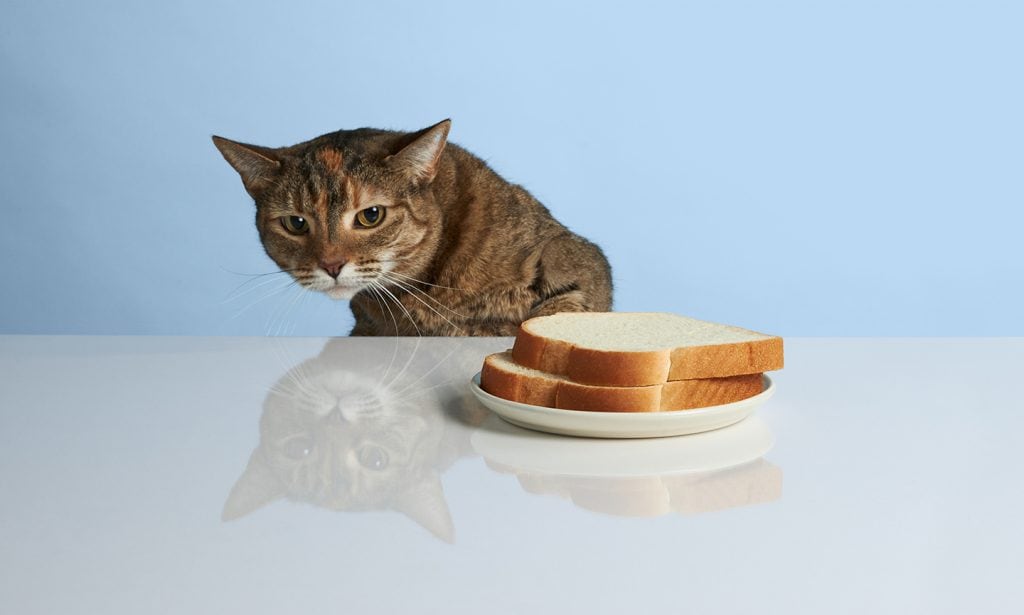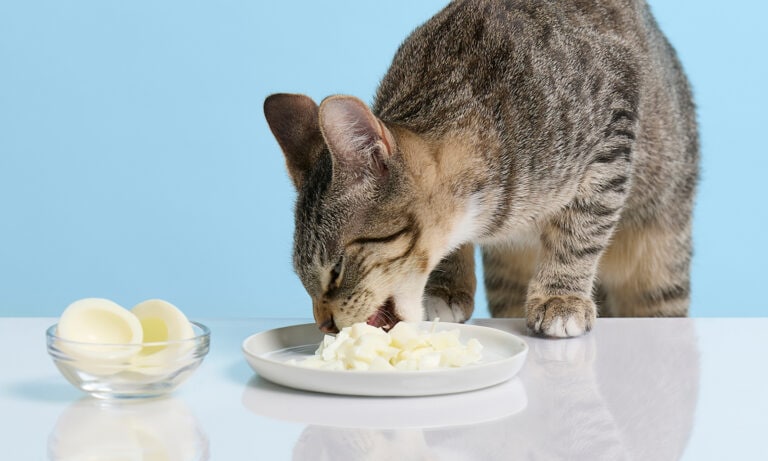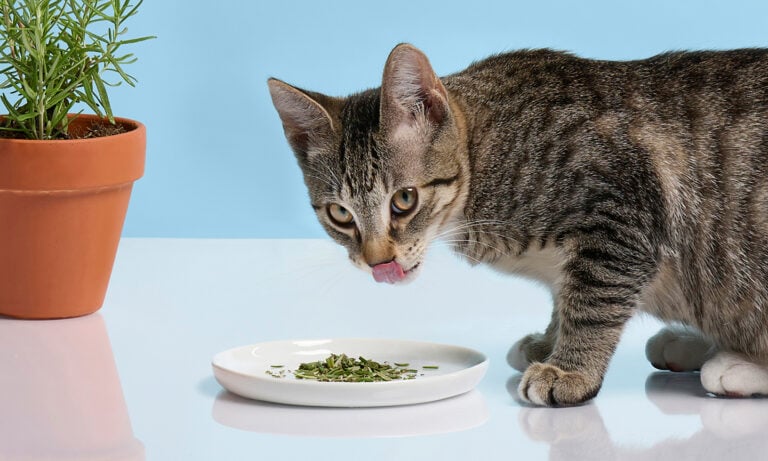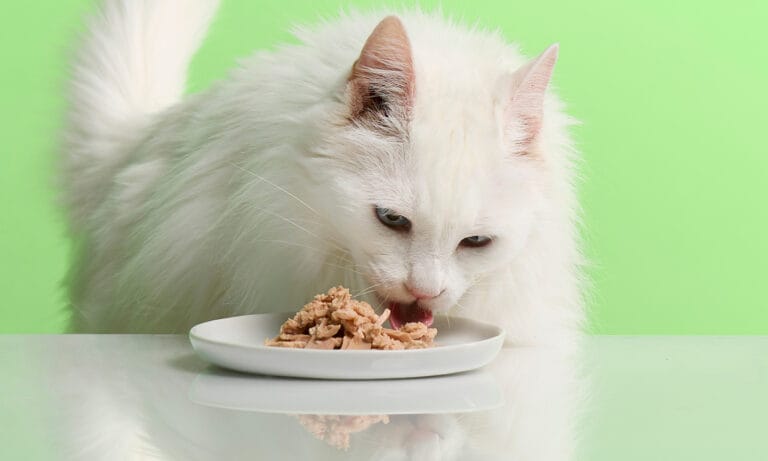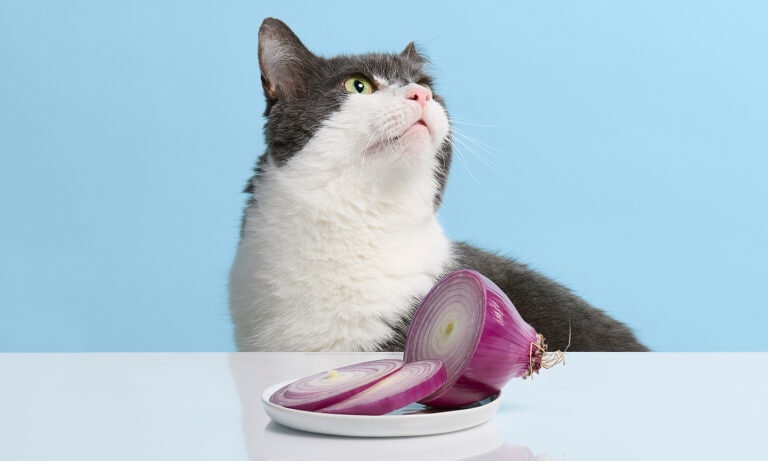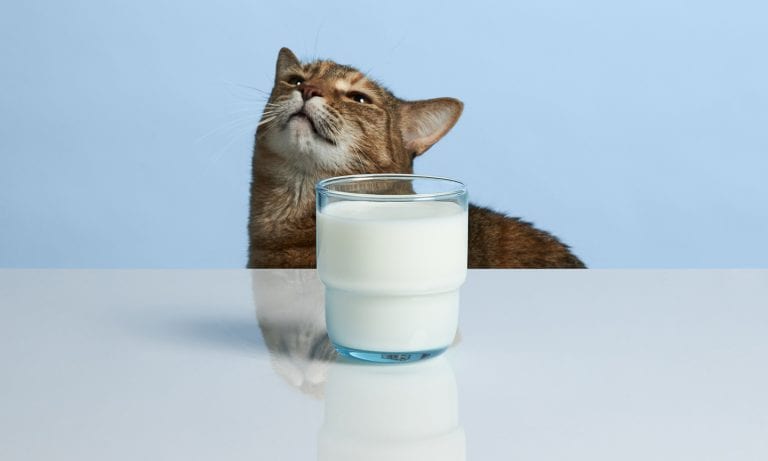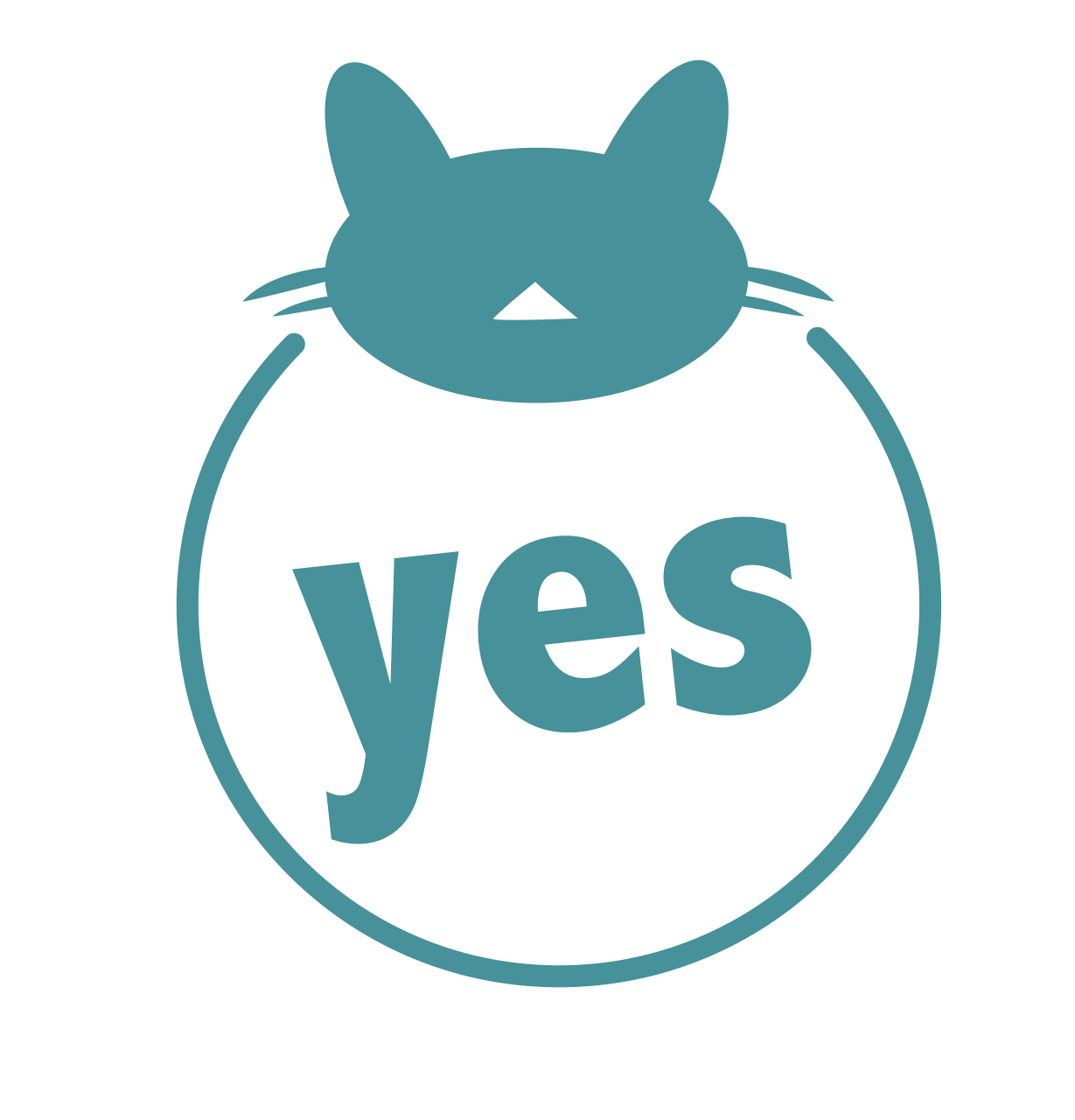
Yes, cats can eat bread—"as long as it’s regular, plain baked bread and limited to small amounts," says Dr. Rachel Barrack, DVM, CVA, CVCH, owner of NYC-based veterinary practice Animal Acupuncture.
Here's what pet parents should know about breaking bread with cats.
Click the buttons to jump to each section:
FAQs About Cats and Bread
Q:How much bread can a cat eat?
A:Cats can eat a small, bite-sized, plain piece of bread—a 1/4-inch square—every once in a while, says Dr. Deborah Bayazit, DVM, co-owner and medical director of Brilliant Veterinary Care in NYC.
Why such a small piece? Treats should account for no more than five to 10 percent of a cat's daily caloric intake, and serving too much bread could mess with your cat’s nutritional balance.
Q:How often can a cat eat bread?
A:Cats can eat bread a couple times a week; however, be mindful of the carbs in bread. Cats don’t need carbohydrates, and they get all the nutrients they need from a meat-based diet. If they fill up on a food such as bread, it can upset their overall nutritional balance.
Q:Is bread bad for cats? What happens if a cat eats bread?
A:Bread can be bad for cats who overindulge. Because bread has no nutritional value for felines, weight gain could be a real problem, Dr. Bayazit says. And for cats with health issues—like obesity, diabetes, heart or kidney disease—the results from eating bread could exacerbate their conditions.
Other troubles to look out for would be:
- Gastrointestinal distress, diarrhea, or vomiting: If bread just doesn’t agree with your cat’s stomach, digestive system signs such as these can show up.
- A full tummy: If a cat overdoes it on bread, they’ll be too full to eat their regular balanced cat food, which is needed to meet their daily nutritional requirements.
Q:Can cats eat gluten-free bread?
A:Cats can eat gluten-free bread. Providing they’re in good health and don’t have an allergy to gluten (which is actually rare), gluten-free bread can make for a safe, acceptable treat. The same feeding guidelines apply:
- Cats can nibble on a small, bite-sized piece of plain gluten-free baked bread once or twice a week. And when we say "plain," we mean it: no toppings and no spices or flavorings of any kind).
- Felines with health conditions should stay away: Kitties with diabetes, kidney or heart disease should not be given any bread.
Q:What is something similar to bread that cats can eat?
A:“Try a soft tidbit made specifically for cats,” Dr. Bayazit says.
Q:Why is my cat obsessed with eating bread?
A:Cats may be obsessed with eating bread due to the carb factor, Dr. Bayazit says.
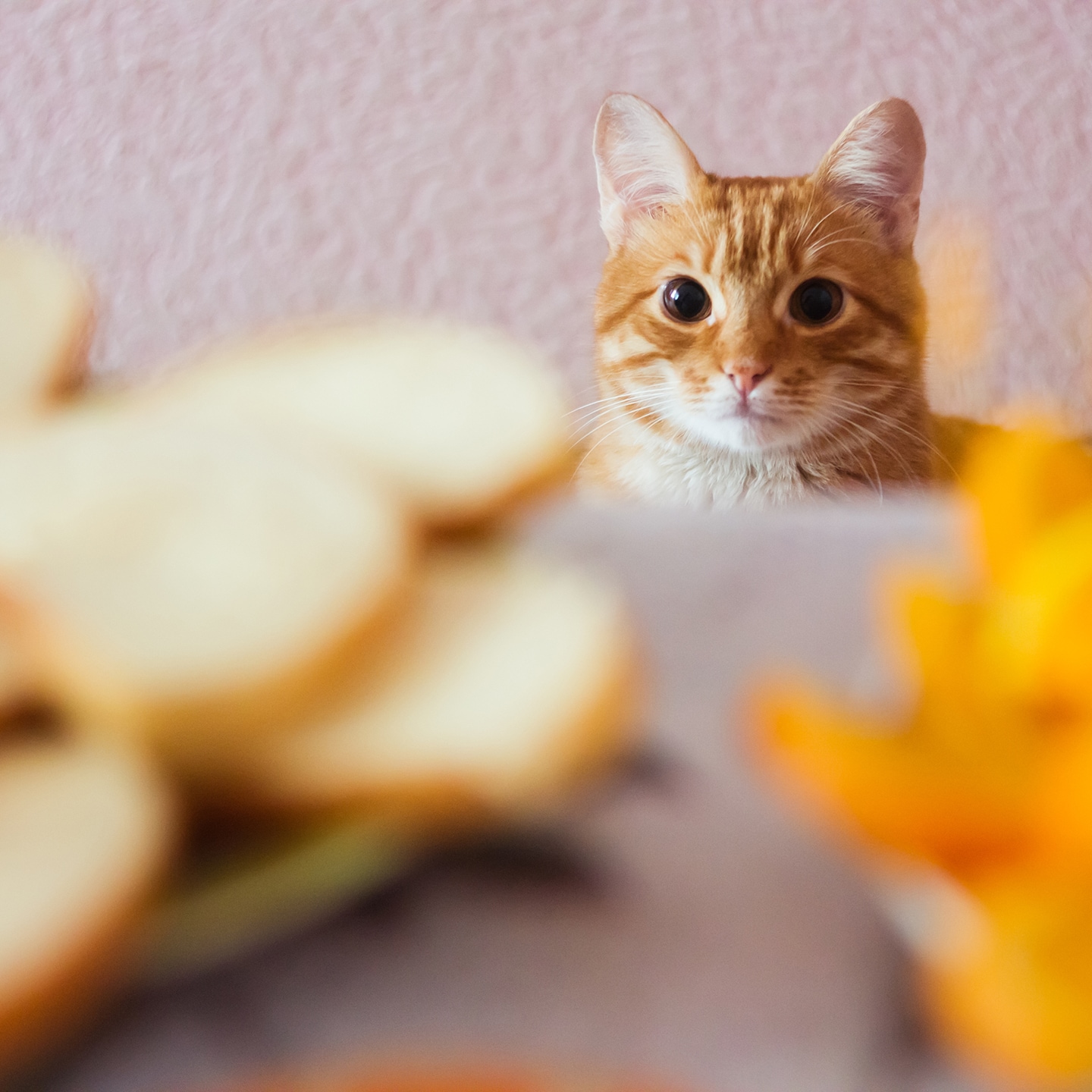
Benefits of Feeding Cats Bread
If you’ve got a kitty who just can’t live without their daily bread, rest assured that there are a couple of good points to serving it.
The benefits of serving cats bread include:
- It’s a safe, nontoxic cat treat. As long as there are no health issues, a little piece of baked bread (plain white, wheat or pumpernickel bread) is perfectly fine to serve as an occasional snack.
- It’s a good way to hide medicine. Let’s face it, nobody likes taking medicines—not the least of which are our feline friends. But if you’ve got a bread-loving cat and their health allows it, concealing their pill in a bit of bread gets a green light. “Though it’s not my first choice, I’m OK with it as a means to get meds in,” says Dr. Barrack.
Downsides of Feeding Cats Bread
For starters, while bread may be nontoxic, it has no nutritional value for cats and provides unnecessary carbs, says Dr. Bayazit.
The other downsides of feeding cats bread include:
- Bread isn’t attractive to cats. Why? “[Cats are] carnivores and like more meaty-type things,” says Dr. Bayazit. Cats are also "very smell-oriented," she adds, "and bread doesn’t really smell like much.” Because their eating is so olfactory-based, don’t be surprised if your kitty turns up their nose to a proffered bread treat.
- Bread is empty calories, and doesn’t help with cat needs nor have any real benefit to cat nutrition, overall health and well-being, says Dr. Barrack.
- Cats primarily need meat. They are obligate carnivores, meaning meat is their nature-intended pet food. If they gobble down too many carbohydrates, they’ll be too full to chow down on their regular, protein-based cat food. Plus, some cats may not handle bread well. Their gastrointestinal tract is not set up to process carbohydrates smoothly. So, watch out for signs of digestive system disagreement in the cat’s stomach, like diarrhea, vomiting or gas.
- Bread is ill-advised for cats with medical issues. Bread can have a high salt content. That—along with the carb load cats might get from imbibing—can be harmful to felines with cat health conditions such as obesity, diabetes, heart or kidney disease.
- Some bread ingredients are often toxic to cats. The kind of bread matters. Savory breads are typically baked with things bad for cats, including seasonings such as garlic or onion (which can cause anemia in purr babies), says Dr. Barrack. Sweet breads frequently have raisins, which can result in acute kidney failure when ingested.
- Raw bread dough is dangerous for cats. Once raw bread is consumed, it can lead to bloating that can be life-threatening, says Dr. Barrack. The yeast in raw dough produces ethanol alcohol, which can result in seizures, respiratory distress and even fatality in cats.
How to Feed Bread to Cats
If you’ve got a cat critter who seems interested in bread, or you just want to try a portion as a novel way to hide a med, there are a few things to know before casting that bread upon the waters.
Here are some tips for serving bread to cats:
- Give bread as a once-in-a-while treat. “Bread cat treats should be limited,” says Dr. Barrack, adding that “cats need diets with lots of protein and fat. They don’t need carbohydrates. If your cat happens to like bread, think of it as an infrequent snack, and restrict any snack portions to no more than five to 10 percent of their calorie intake each day.
- Keep servings small. “Stick with small, bite-sized pieces of bread,” says Dr. Bayazit. A 1/4-inch square a couple of times a week should be plenty.
- Serve plain bread that’s baked. Cats can eat include plain white, wheat or pumpernickel bread. Steer clear of sweet and savory breads that have ingredients that are toxic to cats, including garlic, onion, tomatoes, raisins and chocolate. And avoid breads with added herbs or toppings. Again, keep it plain.
- Avoid raw bread dough. Raw, unbaked bread is especially harmful for cats, says Dr. Barrack. That’s because the yeast in uncooked dough produces ethanol alcohol and can cause life-threatening symptoms, like bloating, seizures and respiratory distress.
- Try it for hiding medicines. Giving cats medicine is not exactly high on a pet parent’s list of fun things to do with your buddy. Bread can come in handy, though. You may be able to hide a pill in a soft piece of baked bread; or if the vet approves, insert some liquid medicine on it.
- What your cat for any reactions. If you decide to give your cat a toast treat, make sure they don’t have any health conditions (like diabetes, heart or kidney disease), and watch out for negative reactions. Many cats will do just fine with a nibble of bread, whereas it might not agree with others. Stop feeding them bread if you see symptoms such as vomiting, diarrhea or other gastrointestinal upset.
What else can cats eat?
Share:
